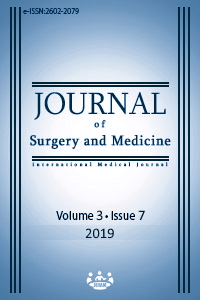Carotid intima-media thickness and cardiac functions in children with neurofibromatosis type 1
Keywords:
Neurofibromatosis, Carotid intima-media thickness, HeartAbstract
Aim: Neurofibromatosis type 1 is a multisystem disorder, affecting primarily the skin, nervous and musculoskeletal systems. Various cardiovascular abnormalities, ranging from congenital heart disease to vasculopathy and hypertension are main clinical features of cardiovascular involvement. The aim of this study was to evaluate cardiac functions and carotid intima-media thickness by conventional and tissue Doppler echocardiography in terms of vasculopathy and cardiac involvement in children with neurofibromatosis type 1.
Methods: A cross-sectional study is designed with 36 Neurofibromatosis patients (20 boy and 16 girl) as study group, with a mean age of 9.7(3.5) years with 36 healthy controls (18 males and 18 females) with a mean age of 10.3(2.2) years. Instant blood pressures were measured. Conventional and tissue Doppler echocardiography were performed. Carotid intima-media thickness, left ventricular ejection fraction and left ventricular fractional shortening were measured with M mode. Mitral early (E), late (A) flow velocities were measured by pulsed-wave Doppler, mitral early (E), late (A) flow velocities ratio was calculated. Tissue Doppler echocardiography was performed from the lateral annular junction of mitral valve and left ventricular myocardial performance index (Tei) index was calculated. Early diastolic flow (E') velocity was measured with tissue Doppler echocardiography.
Results: Left ventricular systolic functions were normal in both groups. Mitral early flow velocities were lower (P<0.001) in the study group. Also Mitral early / late velocities ratio was significantly lower (P=0.004) and mitral early flow velocity/ tissue Doppler early diastolic flow velocity ratio was higher (P=0.045) in the study group. The left ventricular Tei index was calculated as 0.42 (0.1) in the study group and 0.39 (0.1) in the healthy controls (P=0.03). The mean of carotid intima-media thickness was 0.46 (0.01) in the study group and 0.44 (0.01) in the control group (P=0.002). Systolic blood pressures were higher in the study group (P=0.04).
Conclusion: Tei index and diastolic flow velocities in mitral valve support the left ventricle diastolic dysfunction in children with neurofibromatosis type 1. Carotid intima-media thickness suggests vasculopathy and early effects of hypertension due to neurofibromatosis type 1.
Downloads
References
Listermck R, Charrow J. Neurofibromatosis type 1 in childhood. Adv Dermatol. 2004;20:75-115.
Hirbe AC, Gutmann DH. Neurofibromatosis type 1: a multidisciplinary approach to care. Lancet Neurol. 2014 Aug;13(8):834-43. doi: 10.1016/S1474-4422(14)70063-8
Tedesco MA, Ratti G, Di Salvo G, Martiniello AR, Limongelli G, Grieco M, et al. Noninvasive evaluation of arterial abnormalities in young patients with neurofibromatosis type 1. Angiology. 2000 Sep;51(9):733-41
Oderich GS, Sullivan TM, Bower TC, Gloviczki P, Miller DV, Babovic-Vuksanovic D, et al. Vascular abnormalities in patients with neurofi bromatosis syndrome type I: clinical spectrum, management, and results. J Vasc Surg. 2007;46:475–84.
Anon. National Institutes of Health Consensus Development Conference Statement: neurofi bromatosis—Bethesda, MD, USA, July 13–15, 1987. Neurofibromatosis. 1988;1:172–8.
Tei, C, Ling LH, Bailey KR, Hodge Do, Tajik AJ, Seward JB. New index of combined systolic and diastolic myocardial performance: a simple and reproducible measure of cardiac function–a study in normals and dilated cardiomyopathy. J Cardiol. 1995;26: 357-66.
Lin AE, Birch PH, Korf BR, Tenconi R, Niimura M, Poyhonen M, et al. Cardiovascular malformations and other cardiovascular abnormalities in neurofibromatosis 1. Am J Med Genet. 2000;95:108–17.
Tedesco MA, Di Salvo G, Natale F, Pergola V, Calabrese E, Grassia C, et al. The heart in neurofibromatosis type 1: an echocardiographic study. Am Heart J. 2002;143:883–8.
Baroncini LAV, Sylvestre LC, Baroncini CV, Pecoits R Filho. Assessment of Carotid Intima-Media Thickness as an Early Marker Of Vascular Damage In Hypertensive Children. Arq Bras Cardiol. 2017 May;108(5):452-7. doi: 10.5935/abc.20170043.
Xu J, Ismat FA, Wang T, Yang J, Epstein JA. NF1 Regulates a Ras-Dependent Vascular Smooth Muscle Proliferative Injury Response. Circulation. 2007;116:2148-56.
Downloads
- 1268 1857
Published
Issue
Section
How to Cite
License
Copyright (c) 2019 Alev Arslan
This work is licensed under a Creative Commons Attribution-NonCommercial-NoDerivatives 4.0 International License.
















